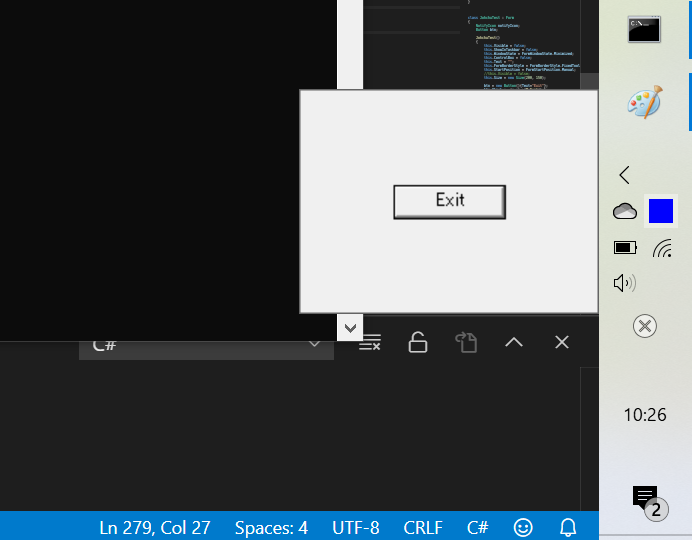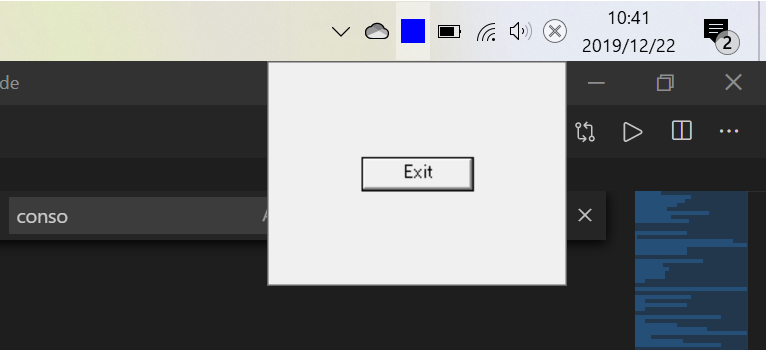環境
Windows10。例によってライブラリレスです。
スクショ
アイコンは面倒なので、ただの青い四角にしてます。
アイコンをクリックすると、表示・非表示を切り替えます。
例として、右配置と上配置のスクショを載せておきます。
右配置
上配置
やっていること
以下のような感じ。Formは起動時に生成しておく。
(1). 通知領域に常駐する(NotifyIcon)
(2). クリックするとタスクバーを探す
(2-1). タスクバーをWin32API使って検出する(さらに、プロセスが正規のパスにあるexplorer.exeであることもチェックする)
(2-2). タスクバーの矩形領域(スクリーン上の座標とサイズ)を取得する
(2-3). タスクバーの所属するスクリーンを判定し、座標とサイズをもとに、タスクバーが左右上下のどこに配置されているかを判定する
(3). クリックされた位置とタスクバーの配置情報をもとに、表示するFormの位置を決める
ソースコード
using System;
using System.ComponentModel;
using System.Diagnostics;
using System.Drawing;
using System.IO;
using System.Runtime.InteropServices;
using System.Text;
using System.Windows.Forms;
internal class TaskbarInfo
{
public IntPtr WindowHandle{get; private set;}
bool _lockInfo; // trueを設定時、情報更新を停止させる
Rectangle _windowRect;
Rectangle _screenRect;
public enum TaskbarDockStyle {
Top=0,
Bottom=1,
Left=2,
Right=3
}
// -----------------------------------------------------------
public void UpdateInfo()
{
UpdateInfo(false);
}
public bool UpdateInfo(bool throwError)
{
bool retCode;
NativeMethods.WINDOWINFO wi;
wi = MyGetWindowInfo(WindowHandle, out retCode);
if ( retCode ) {
_windowRect = wi.rcWindow.rect;
// タスクバーが配置されているスクリーンを取得する
Point p = new Point(_windowRect.X + _windowRect.Width/2, _windowRect.Y + _windowRect.Height/2);
Screen screen = Screen.FromPoint(p);
_screenRect = screen.Bounds;
}
else {
// failed
throw new Win32Exception( Marshal.GetLastWin32Error() );
}
return retCode;
}
public void LockInfo()
{
UpdateInfo();
_lockInfo = true; // trueを設定時、情報更新を停止させる
}
public void UnlockInfo()
{
UpdateInfo();
_lockInfo = false;
}
// -----------------------------------------------------------
public Rectangle Rect{
get {
if ( !_lockInfo ) { UpdateInfo(); }
return _windowRect;
}
}
public Size Size{
get {
if ( !_lockInfo ) { UpdateInfo(); }
return _windowRect.Size;
}
}
public TaskbarDockStyle Dock{
get{
if ( !_lockInfo ) { UpdateInfo(); }
// ※※※ 以下、UpdateInfoが呼ばれないように、プロパティではなくフィールドを直接参照すること。
// タスクバーの移動やスクリーン設定の変更などのタイミングによっては
// おそらく、情報の整合性が取れない場合がありえる。
// その場合は一番使われていそうな bottom を返すようにする。
if ( _screenRect.Width == _windowRect.Width ) {
if ( _screenRect.Top == _windowRect.Top ) {
return TaskbarDockStyle.Top;
}
else if ( _screenRect.Bottom == _windowRect.Bottom ) {
return TaskbarDockStyle.Bottom;
}
}
if ( _screenRect.Height == _windowRect.Height ) {
if ( _screenRect.Left == _windowRect.Left ) {
return TaskbarDockStyle.Left;
}
else if ( _screenRect.Right == _windowRect.Right ) {
return TaskbarDockStyle.Right;
}
}
return TaskbarDockStyle.Bottom;
}
}
// -----------------------------------------------------------
static readonly string PrimaryTaskbarClassName = "Shell_TrayWnd";
static readonly string TaskbarExeName = "explorer.exe";
static class NativeMethods
{
[DllImport("user32.dll", SetLastError = true, CharSet = CharSet.Auto)]
public static extern IntPtr FindWindowEx(IntPtr parentWnd, IntPtr previousWnd, string className, string windowText);
[DllImport("user32.dll", SetLastError = true, CharSet = CharSet.Auto)]
public static extern int GetClassName(IntPtr hWnd, StringBuilder lpClassName, int nMaxCount);
[DllImport("user32.dll", SetLastError = true)]
public static extern int GetWindowThreadProcessId(IntPtr hWnd, out int lpdwProcessId);
[DllImport("user32.dll", SetLastError = true)]
public static extern int GetWindowInfo(IntPtr hwnd, ref WINDOWINFO pwi);
[StructLayout(LayoutKind.Sequential)]
public struct WINDOWINFO
{
public int cbSize;
public RECT rcWindow;
public RECT rcClient;
public int dwStyle;
public int dwExStyle;
public int dwWindowStatus;
public uint cxWindowBorders;
public uint cyWindowBorders;
public short atomWindowType;
public short wCreatorVersion;
}
[StructLayout(LayoutKind.Sequential)]
public struct RECT
{
public int left;
public int top;
public int right;
public int bottom;
public int width{get{return right-left;}}
public int height{get{return bottom-top;}}
public Rectangle rect{get{return new Rectangle(left,top,width,height);}}
}
}
private TaskbarInfo(IntPtr windowHandle)
{
_lockInfo = false;
WindowHandle = windowHandle;
UpdateInfo(true);
}
public static TaskbarInfo GetPrimaryTaskbarInfo()
{
string expectedExePath = Path.Combine(Environment.GetFolderPath(Environment.SpecialFolder.Windows), TaskbarExeName).ToLowerInvariant();
IntPtr hWnd = IntPtr.Zero;
while ( IntPtr.Zero != (hWnd = NativeMethods.FindWindowEx(IntPtr.Zero, hWnd, PrimaryTaskbarClassName, ""))) {
int pid;
NativeMethods.GetWindowThreadProcessId(hWnd, out pid);
Process p = Process.GetProcessById(pid);
ProcessModule pm = p.MainModule; // ※MainModuleでよいのかよくわからない
//Console.WriteLine(pm.FileName);
if ( pm.FileName.ToLowerInvariant() == expectedExePath ) {
// c:\windows\explorer.exe がつくった正規のタスクバーと判定した
return CreateTaskbarInfo(hWnd);
}
}
return null; // failed
}
static TaskbarInfo CreateTaskbarInfo(IntPtr windowHandle)
{
try {
return new TaskbarInfo(windowHandle);
}
catch(Win32Exception e) {
Console.WriteLine(e);
}
return null;
}
public Rectangle CalcNearRect(Point baseP, Size sz)
{
bool backup = _lockInfo;
try {
_lockInfo = true;
var dock = Dock;
Point p = new Point();
switch ( dock ) {
case TaskbarDockStyle.Left:
p.X = _windowRect.Right;
p.Y = baseP.Y - sz.Height/2;
break;
case TaskbarDockStyle.Right:
p.X = _windowRect.Left - sz.Width;
p.Y = baseP.Y - sz.Height/2;
break;
case TaskbarDockStyle.Top:
p.X = baseP.X - sz.Width/2;
p.Y = _windowRect.Bottom;
break;
case TaskbarDockStyle.Bottom:
p.X = baseP.X - sz.Width/2;
p.Y = _windowRect.Top - sz.Height;
break;
}
/*
if ( p.X + sz.Width > _screenRect.Right ) {
p.X = _screenRect.Right - sz.Width;
}
if ( p.X < _screenRect.Left ) {
p.X = _screenRect.Left;
}
if ( p.Y + sz.Height > _screenRect.Bottom ) {
p.Y = _screenRect.Bottom - sz.Height;
}
if ( p.Y < _screenRect.Top ) {
p.Y = _screenRect.Top;
}
*/
return new Rectangle(p, sz);
}
finally {
_lockInfo = backup;
}
}
// if GetWindowInfo failed, retCode = false.
static NativeMethods.WINDOWINFO MyGetWindowInfo(IntPtr hWnd, out bool retCode)
{
var wi = new NativeMethods.WINDOWINFO();
wi.cbSize = Marshal.SizeOf(wi);
retCode = (NativeMethods.GetWindowInfo(hWnd, ref wi) != 0);
return wi;
}
}
class JohchuTest : Form
{
NotifyIcon notifyIcon;
Button btn;
JohchuTest()
{
this.Visible = false;
this.ShowInTaskbar = false;
this.WindowState = FormWindowState.Minimized;
this.ControlBox = false;
this.Text = "";
this.FormBorderStyle = FormBorderStyle.FixedToolWindow;
this.StartPosition = FormStartPosition.Manual;
//this.Visible = false;
this.Size = new Size(200, 150);
btn = new Button(){Text="Exit"};
btn.Click += (s,e)=>{MyExit();};
btn.Location = new Point((200-btn.Width)/2, (150-btn.Height)/2);
Controls.Add(btn);
notifyIcon = new NotifyIcon();
notifyIcon.Icon = Create16x16Icon();
notifyIcon.Visible = true;
notifyIcon.MouseClick += NotifyIcon_MouseClick;
var menu = new ContextMenuStrip();
menu.Items.AddRange(new ToolStripMenuItem[]{
new ToolStripMenuItem("E&xit", null, (s,e)=>{MyExit();}, "Exit")
});
notifyIcon.ContextMenuStrip = menu;
//HandleCreated+=(s,e)=>{Console.WriteLine("HandleCreated event occured.");};
//Load+=(s,e)=>{Console.WriteLine("Load event occured.");};
//Shown+=(s,e)=>{Console.WriteLine("Shown event occured.");};
//Activated+=(s,e)=>{Console.WriteLine("Activated event occured.");};
}
void NotifyIcon_MouseClick(object sender, MouseEventArgs e)
{
if ( e.Button == MouseButtons.Left ) {
if ( this.WindowState == FormWindowState.Normal ) {
this.WindowState = FormWindowState.Minimized;
}
else {
try {
this.Opacity = 0; // 移動前に表示されてしまうので透過させておく
this.WindowState = FormWindowState.Normal;
MoveFormTo(Cursor.Position);
}
finally {
this.Opacity = 1;
}
}
}
}
bool MoveFormTo(Point p)
{
TaskbarInfo taskbar = TaskbarInfo.GetPrimaryTaskbarInfo();
Rectangle rect = taskbar.CalcNearRect(p, Size);
this.Location = rect.Location;
if ( taskbar == null ) {
return false;
}
return true;
}
// -------------------------------------------
static Icon Create16x16Icon()
{
Bitmap bmp = new Bitmap(16,16);
using ( Graphics g = Graphics.FromImage(bmp) ) { g.Clear(Color.Blue); }
return Icon.FromHandle(bmp.GetHicon());
}
void MyExit()
{
var e = new CancelEventArgs();
notifyIcon.Visible = false;
Application.Exit(e);
if (e.Cancel) {
Console.WriteLine("Application.Exit is canceled.");
notifyIcon.Visible = true;
}
}
[STAThread]
static void Main(string[] args)
{
//Application.EnableVisualStyles();
Application.Run(new JohchuTest());
}
}
マルチディスプレイ(マルチスクリーン)で注意すべきこと
- マルチ画面になると、画面の左上=(0,0)とは限らなくなる。
- 主画面(
PrimaryScreen)が右側や下側にくる場合がありえる。
マルチディスプレイにおけるタスクバー
- 通知領域は主タスクバー(
Shell_TrayWnd)にしか表示されない。 -
PrimaryScreen以外の画面にShell_TrayWndを置くことができる。
(つまり、主画面に主タスクバーがいない場合がある。)
感想
.NETではタスクバーは取り残されているような気がする。
(NotifyIconはあるものの、お作法的なものがあまり見つけられない。)
わりと需要ある機能だと思うが、標準で機能提供されてないものか。

